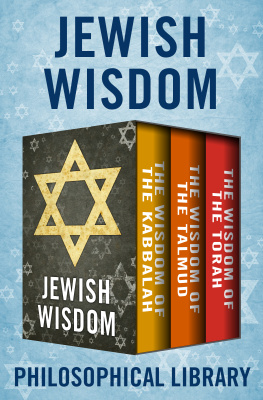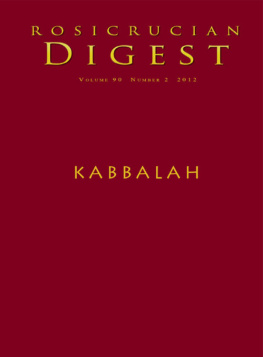SYMBOLS
OF THE
KABBALAH

SYMBOLS
OF THE
KABBALAH

PHILOSOPHICAL AND
PSYCHOLOGICAL PERSPECTIVES
SANFORD L. DROB

The author gratefully acknowledges permission to reprint portions of the following:
S. Drob. The Metaphors of Tikkun Haolam: Their Traditional Meaning and Contemporary Significance in Jewish Review 3:6. Reprinted by permission of the Jewish Review, Inc. Copyright 1990.
S. Drob. The Sefirot: Kabbalistic Archetypes of Mind and Creation in Cross Currents 47. Copyright 1997. Reprinted by permission of the publisher.
S. Drob. Tzimtzum: A Kabbalistic Theory of Creation in Jewish Review 3:5. Reprinted by permission of the Jewish Review, Inc. Copyright 1990.
R. Elior. The Paradoxical Ascent to God: The Kabbalistic Theosophy of Habad Hasidism. Reprinted by permission of the State University of New York Press. Copyright 1993. All rights reserved.
M. Idel. Hasidism: Between Ecstasy and Magic. Reprinted by permission of the State University of New York Press. Copyright 1995. All rights reserved.
M. Idel. Kabbalah: New Perspectives. Copyright 1988 by Yale University Press. Reprinted by permission of the publisher.
D. Meltzer. The Secret Garden: An Anthology in the Kabbalah. Copyright 1976, 1998 by David Meltzer. Reprinted by permission of the publisher.
R. Nozick. Philosophical Explanations. Copyright 1981. Reprinted by permission of the publisher.
D. Wilder Menzi and Z Padeh. The Tree of Life: Chayyim Vitals Introduction to the Kabbalah of Isaac Luria. Copyright 1999. Reprinted by permission of the publisher.
I. Robinson. Moses Cordoveros Introduction to Kabbalah: An Annotated Translation of His Or Neerav. Copyright 1994. Reprinted by permission of the publisher.
I. Tishby and F. Lachower. The Wisdom of the Zohar, Vols., I, II, and III. Reprinted by permission of The Littman Library of Jewish Civilization. Copyright 1989.
S. Zalman. Likutei Amarim-Tanya. Copyright 1983. Reprinted by permission of the publisher.
This book was set in 10 pt. Galliard by Alabama Book Composition of Deatsville, AL, and printed and bound by Book-Mart Press, Inc. of North Bergen, NJ.
Copyright 2000 by Sanford L. Drob
10 9 8 7 6 5 4 3 2 1
All rights reserved. No part of this book may be used or reproduced in any manner whatsoever without permission from Jason Aronson Inc. except in the case of brief quotations in reviews for inclusion in a magazine, newspaper, or broadcast.
Library of Congress Cataloging-in-Publication Data
Drob, Sanford L.
Symbols of the kabbalah: philosophical and psychological perspectives / by Sanford L. Drob.
p. cm.
Includes bibliographical references and index.
ISBN 978-0-7657-6126-2
1. CabalaTerminology. I. Title
BM526 D765 2000
296.1'6dc21
99048145
Printed in the United States of America on acid-free paper. For information and catalog, write to Jason Aronson Inc., 230 Livingston Street, Northvale, NJ 07647-1726, or visit our website: www.aronson.com
For
Liliana, Rusansky Drob
Contents
Preface
This work provides a philosophical and psychological interpretation of the major symbols and metaphors of the theosophical Kabbalah. The opening chapter explores a number of factors that have inhibited others from undertaking a philosophical interpretation of the Kabbalah in the past and explores the methodological and conceptual issues involved in providing an analysis of the theosophical Kabbalah from a philosophical and psychological point of view. Chapters Two through Nine each focus upon a major kabbalistic symbol and provide an interpretation of these symbols and the Kabbalah as a whole that strives to be comprehensible and relevant to the contemporary reader. Several of the chapters were originally written as separate essays and appeared (in different form) in The Jewish Review and Crosscurrents.
I am indebted to a number of authors whose works have opened the world of the Kabbalah to those such as myself who are nonspecialists in Hebraic studies; first to Gershom Scholem, whose immense oeuvre has literally defined the field of kabbalistic studies to the general reader; to Isaiah Tishby and Fischel Lachower, whose arrangement and commentary on the Zohar made that work accessible; to Immanuel Schochet, whose commentary on Schneur Zalmans Tanya and essay on the Mystical Concepts of Chasidism first brought me into the world of Lurianic thought; and to many other scholars, such as Moshe Idel, Rachel Elior, and Elliot Wolfson, whose works are cited herein.
On a more personal note I am indebted to the late Professor John Findlay whose works on Hegel and Plato, whose original Neoplatonic philosophy, and whose personal inspiration have constantly informed my efforts at a rational understanding of the Kabbalah. I would also like to thank Rabbi Shimmon Hecht for teaching me Tanya, and Rabbi Joel Kenney for guiding my exploration of Vitals Sefer Etz Chayyim and sharing with me his knowledge of kabbalistic and Hasidic symbolism.
. See Sanford Drob, Tzimtzum: A Kabbalistic Theory of Creation, Jewish Review, Vol. 3, No. 5 (AprilMay 1990); Sanford Drob, The Metaphors of Tikkun Haolam: Their Traditional Meaning and Contemporary Significance, Jewish Review, Vol. 3, No. 6 (June 1990); Sanford Drob, The Sefirot: Kabbalistic Archetypes of Mind and Creation, Crosscurrents 47 (1997):529.
Introduction:
The Kabbalistic Metaphors
This is an ambitious book. Its purpose is the interpretation of the main symbols of the theosophical Kabbalah from a perspective that is accessible and relevant to the contemporary reader. The essays that follow each focus upon a particular kabbalistic symbol, and on the relationship between the Kabbalah and some aspect of ancient or modern thought, and were all written with the conviction that the Kabbalah, particularly as it is expressed in the school of Isaac Luria (the Lurianic Kabbalah), provides a coherent and comprehensive account of the cosmos, and humanitys role within it, that is intellectually, morally, and spiritually significant for contemporary man. It is my view that the Lurianic Kabbalah provides us with a fundamental mythology or basic metaphor, which organizes everything around itself in a manner that is strikingly original, illuminating, and vital for us today.
Although much of this book is an attempt to articulate the philosophical and psychological ideas that are implicit in the Kabbalahs myths, metaphors, and speculations, it is not a work of philosophy or psychology per se. While contemporary philosophy and psychology can provide a vocabulary that will enable us to understand the Kabbalah in a manner that is, from our perspective, perhaps better than the Kabbalists understood it themselves, the Kabbalah cannot be exhaustively described in rational terms. This is because the Kabbalah, as will soon become evident, is an approach to the world that is at once poetical and philosophical, symbolic and conceptual, mystical and logical, prescriptive and descriptive; and any attempt to define it through the categories of traditional philosophy, psychology, ethics, religion, etc., will of necessity miss part of the Kabbalahs essence. This is not only because the Kabbalah transcends the boundaries of these categories but because it is ultimately deconstructive of these categories as well. The conceptual schemes that I utilize in explicating the kabbalistic symbols, while extremely useful, must ultimately be discarded in favor of those symbols themselves.
Next page





